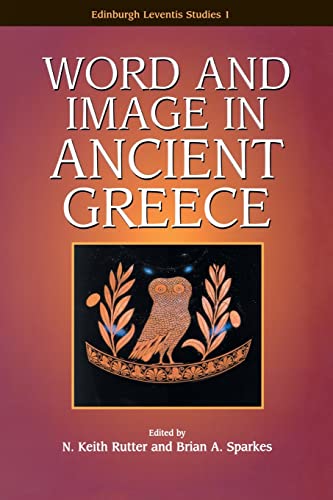Artículos relacionados a Word And Image In Ancient Greece: 1 (Edinburgh Leventis...

Sinopsis
In ancient Greek society communication was largely oral and visual. The epic poets sang and recited the legends that served the Greeks as their historical past; lyric and elegiac poets sang songs of love and death and celebrated military and sporting success to the accompaniment of the lyre and pipes; the art of rhetoric was a vital ingredient in speeches in the assembly and the law courts; in tragedies and comedies actors spoke to audiences of thousands. Of equal importance to the Greeks were the images with which they were always surrounded -- civic and religious monuments, statuary, architectural decoration, and the scenes of myth, fantasy and everyday life with which their vases and vessels were painted and decorated. This volume of new work by leading scholars explores the ways in which these two central aspects of Greek culture interact, and throws new light on their many and related functions. The subjects include the creation of the Greek myths during the early centuries of the first millennium BC when the technique of writing had been lost; the significance of words and images on painted pottery; the relationship between drama on stage and the illustration of the same stories on pottery; and the ways in which stories portrayed in monumental sculpture on temples were understood by the people who came to look at them. Classical Greece produced the beginnings of the tradition of philosophical reflection on the nature and value of images, notably in the work of Plato and Aristotle: the concept of mimesis, concerned with questions both of representation and expression, is directly addressed by several of the authors, and forms an underlying theme of the volume as a whole. The authors are drawn from the historical, archaeological, literary, philosophical and art historical fields of classical study. The book, which contains 50 illustrations, makes a coherent and important contribution to a subject of great current interest to classicists of all disciplines.
"Sinopsis" puede pertenecer a otra edición de este libro.
Acerca del autor
N. Keith Rutter is Honorary Fellow & Professor Emeritus in Classics at the University of Edinburgh. He has published widely on the coinage and history of South Italy and Sicily in the Greek period. His publications include Campanian Coinages 475-380 BC (1979) and Greek Coinages of Southern Italy and Sicily (1997). He has been responsible for steering the Italian volume of the third edition of Historia Numorum towards publication (2001) by the British Museum Press. Brian A. Sparkes is Emeritus Professor of Classical Archaeology at the University of Southampton.
"Sobre este título" puede pertenecer a otra edición de este libro.
EUR 25,56 gastos de envío desde Estados Unidos de America a España
Destinos, gastos y plazos de envíoComprar nuevo
Ver este artículoEUR 19,49 gastos de envío desde Alemania a España
Destinos, gastos y plazos de envíoResultados de la búsqueda para Word And Image In Ancient Greece: 1 (Edinburgh Leventis...
Word And Image In Ancient Greece (Edinburgh Leventis Studies)
Librería: Eve's Book Garden, Albany, CA, Estados Unidos de America
Soft cover. Condición: Near Fine. Tight & clean pages. Covers glossy with a little fading to borders. Nº de ref. del artículo: 038787
Cantidad disponible: 1 disponibles
Word and Image in Ancient Greece
Librería: moluna, Greven, Alemania
Kartoniert / Broschiert. Condición: New. Dieser Artikel ist ein Print on Demand Artikel und wird nach Ihrer Bestellung fuer Sie gedruckt. The book, which contains 50 illustrations, makes a coherent and important contribution to a subject of great current interest to classicists of all disciplines.Über den AutorrnrnEdited by Keith N. Rutter and Brian SparkesKla. Nº de ref. del artículo: 594935187
Cantidad disponible: Más de 20 disponibles
Word And Image In Ancient Greece (Edinburgh Leventis Studies)
Librería: dsmbooks, Liverpool, Reino Unido
paperback. Condición: Good. Good. book. Nº de ref. del artículo: D8S0-3-M-0748614052-6
Cantidad disponible: 1 disponibles

